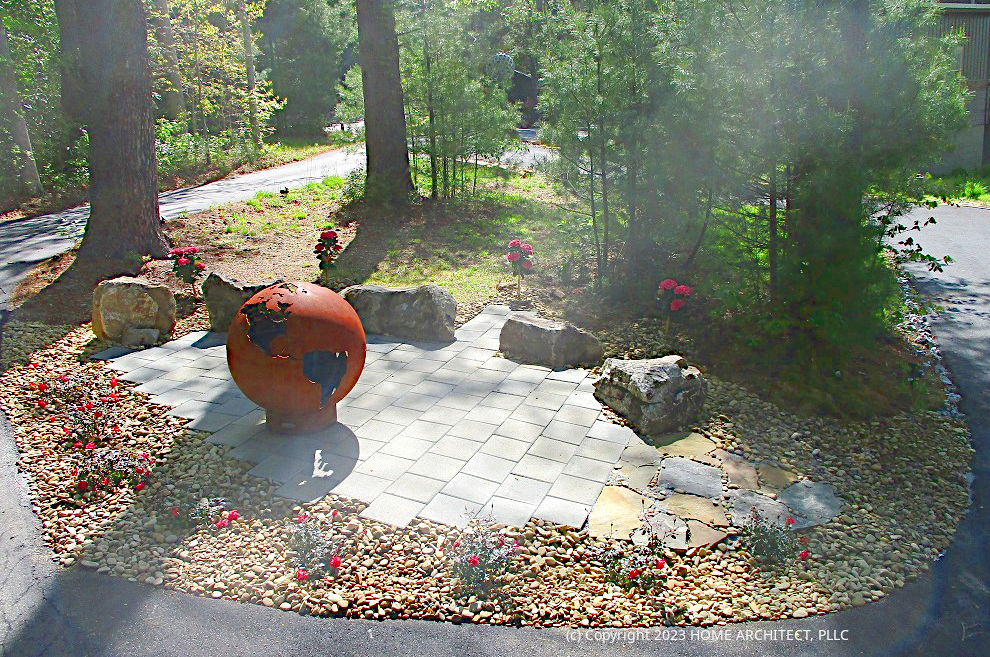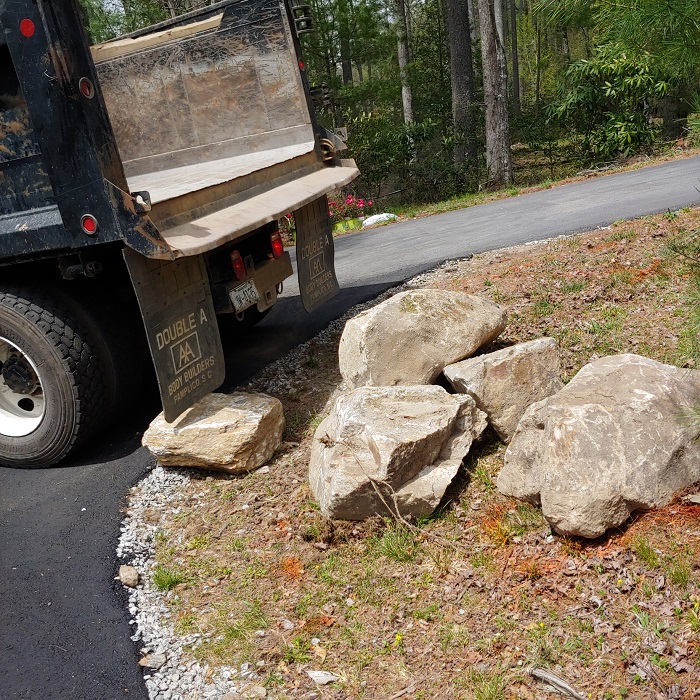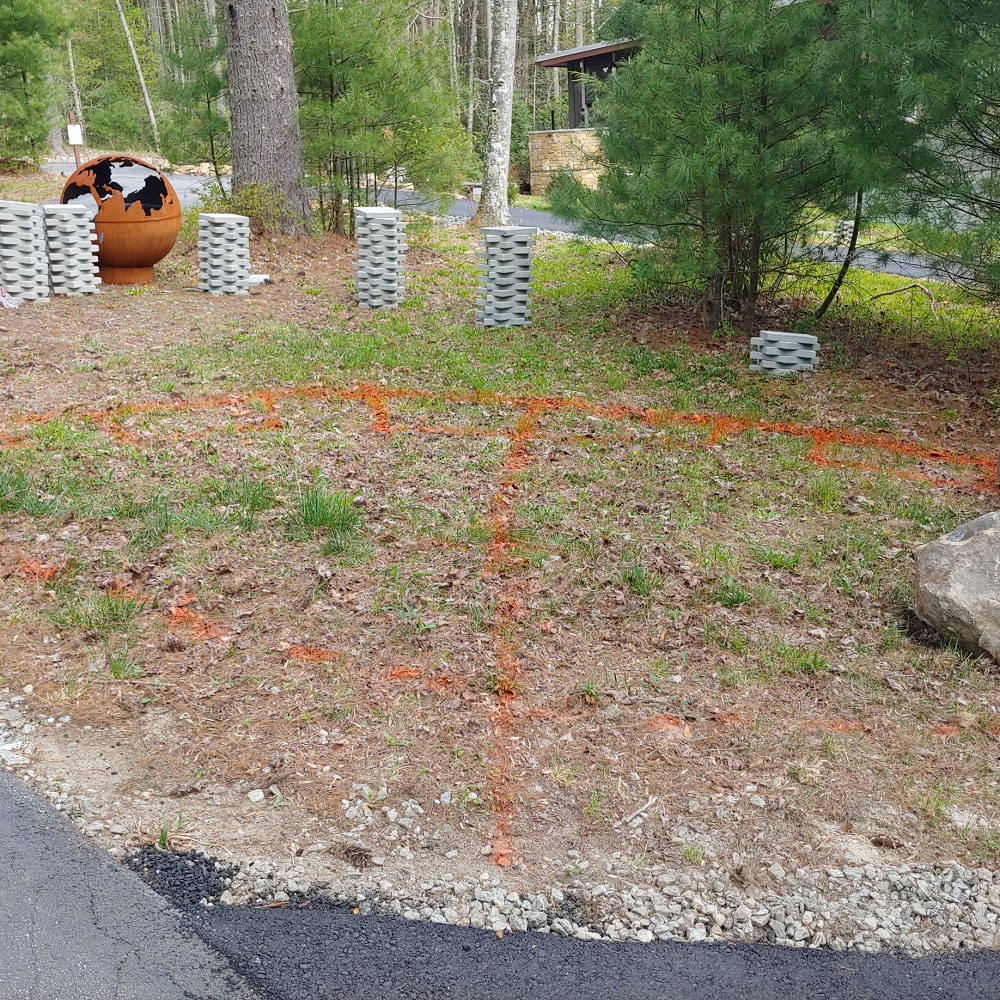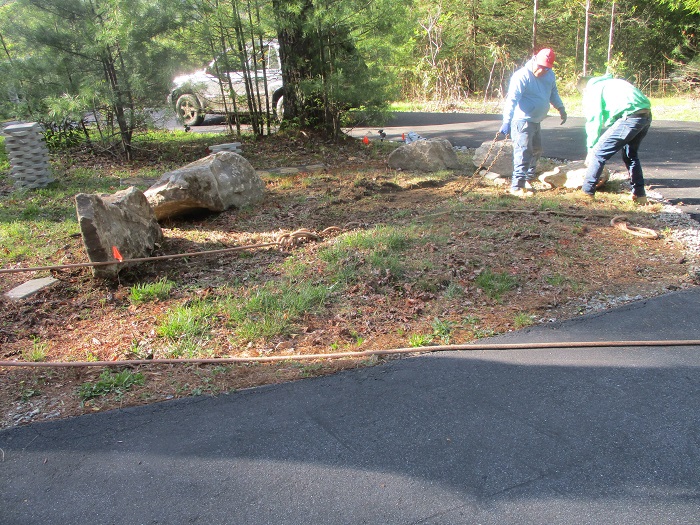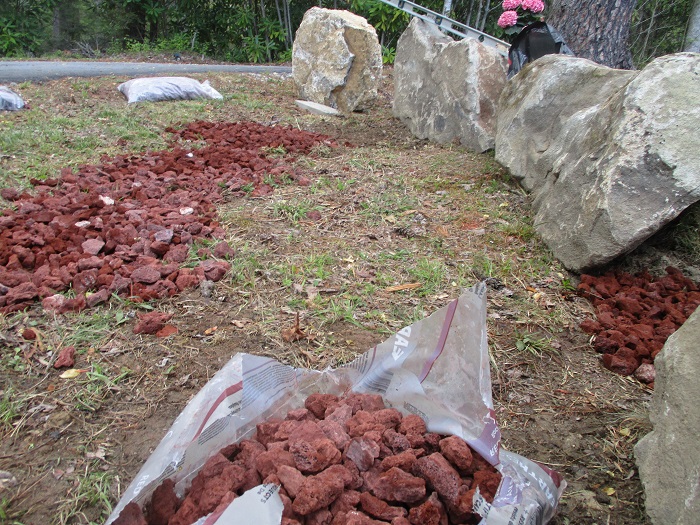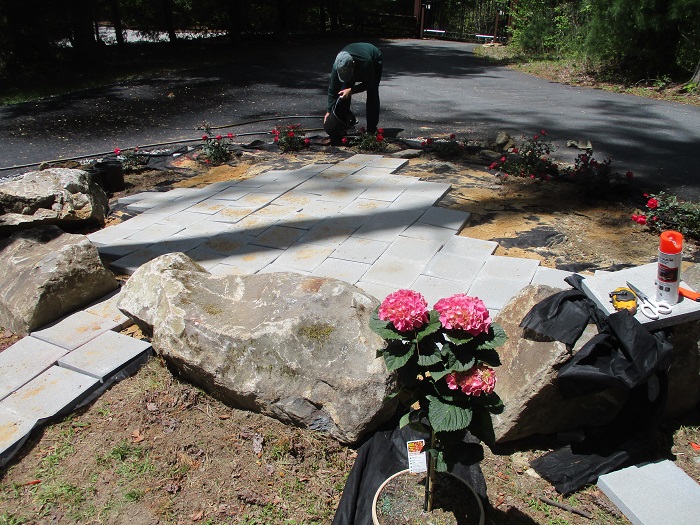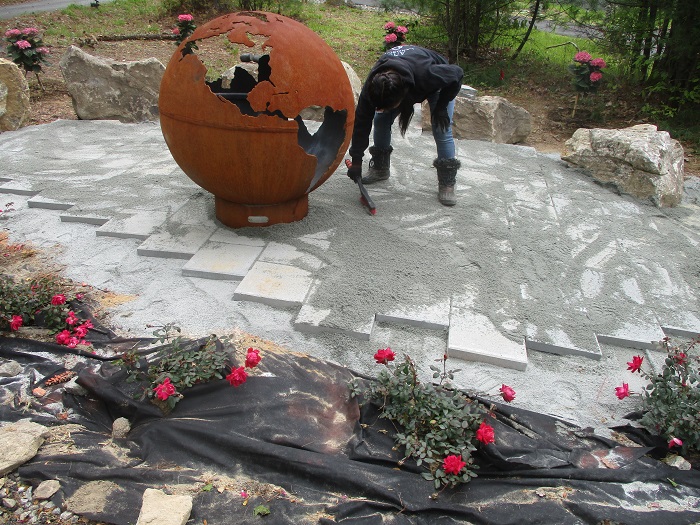Small Park for Land Around House is what this Architect designed and built about 100 feet from his own house.
The above was the final result.
Below you will be able to see the method and means and costs involved with how the Architect accomplished this, step by step, starting with bare ground.
Note: the double knockout roses in the foreground will eventually grow to be much larger with dozens of blooms on each plant. Also, the pink hydrangeas in the rear will become tree-like.
His wife asked for some more color, meaning flowers. Well, being an Architect, he scribbled the following, making it something more significant because the location was just inside the gates to the entry to the property and highly visible to all who enter.
Normally, more formal and precise drawings are required to pull off something like this, but in this particular case, the Architect functioned as his own General Contractor, being on-site continuously during all work, guiding everything. And little did anyone know that the final cost would be substantially more than anyone would predict. See costs below:
COSTS:
To do anything correctly and to have it be virtually maintenance free and look professional and well-done, will end up costing very much more than you would think.
$ 13.86 Planting soil
$ 243. Roses (8)
$ 299.57 Pavers (90, each at only $1.78), sub base gravel, weed control fabric
$1,392.71 Special rusty steel giant sphere world firepit
$ 150. Delivery for firepit globe (approx. 250 pounds)
$ 371.96 Boulder “seats” including delivery
$ 350. Moving boulders into position
$ 300.11 Hydrangeas (4), paver sand (4 bags which was nowhere near enough), misc.
$ 41.70 Edge stakes (8″ long plastic)
$ 112.50 Labor planting 8 roses and 4 hydrangeas
$1,000. Labor removing and replacing pavers, adding another 30 pavers, providing stone screenings setting bed & prep
$ 600. Labor and material for 2 tons of large tan river rock gravel including setting in place
—————–
$4,875.41 Total investment
Divided by approximately 120 SF of paver area= $40.62/ SF of paver area.
PROCESS:
STEP 1: TRIM EXISTING GRASS & WEEDS DOWN TO EARTH
(use eye protection).
STEP 2: BOULDER DELIVERY
5 medium sized boulders were selected from a local stone yard, likely of Tennessee sandstone. Sizes should allow sitting on the rocks after being positioned in the park. Price for these including delivery was a remarkably economical $371.96.
STEP 3: ARCHITECT DRAW OUTLINES OF ORGANIZATION ON THE GROUND, with locations of each boulder in orange layout spray paint
(Note: probably just before now is a good time to have the various elements of the park delivered: firepit, pavers, roses, planting soil, hydrangeas and keep them all well out of the way).
STEP 4: HAVE SUBCONTRACTOR MOVE ROCKS INTO FINAL POSITION (do not attempt to do this yourself)
Note: these rocks weigh from 500 pounds to 2,000 pounds.
A Ford F550 dumptruck was used for pulling power with thick ropes and industrial pulleys wrapped around thick tree trunks to move the boulders. Anyone attempting such things should make sure that they will not end up pulling down a big tree on top of themselves.
STEP 5: PLACE SUB BASE GRAVEL TO EVEN OUT DEEPER AREAS
STEP 6: LAY DOWN WEED CONTROL FABRIC OVER ENTIRE AREA OF PARK TO RECEIVE PAVERS AND FEATURE PLANTINGS
Embarrassing note: Architect is an excellent designer. But he is not a builder. He likes to caution Contractors to stay to building, not designing. Well, he had to end up heeding his own counsel. He made a big mistake trying to use just a little sand (4 bags) and it was no where near enough to level/smooth the area and the pavers he laid down had to be removed and relaid by professionals after they installed a proper stone screenings base (see below).
STEP 7: PLANT THE PLANTS
STEP 8: LAY DOWN ROCK SCREENINGS (gray) AND CAREFULLY LEVEL/SMOOTH BY PROFESSIONALS. This is what the pavers will be placed into, so this must be done professionally. Do not use sand of any kind. Only use gray rock screenings which are angular and compact and tend to stay in place and behave more like cement.
it is important to lay down about 1″ to 3″ of rock screenings first. Then screen/compact them with an 8′ long straight screed board.
Because this land is all sloping everywhere, the Architect had no intentions of making this small park perfectly level. Only smooth. So the pavers would be normal to each other with no ups and downs.
Looks like a concrete slab, doesn’t it? The pros doing this work the board back and forth and up and down, compacting the stone screenings to make a solid smooth base for the pavers.
STEP 9: LAY DOWN PAVERS (by professionals)
Note that this masonry pro is using a rubber mallet to seat each paver down into the rock screenings bed and to make sure each paver has its edges at the same level as those next to it. This also further compacts the rock screenings, which is a good thing.
The Architect snapped a red chalk line from the start point to the other side of the paved area to guide the worker before he began laying the pavers down. The Architect did this so that he could fit 2 pavers between the middle rocks out of the stone circle as an ingress-egress point.
And so the pavers were professionally laid down into their final positions.
STEP 10: SPRAY PAINT KRYLON CLEAR COATING OVER BOTTOM OF RUSTY STEEL FIREPIT BASE
The purpose is to hopefully minimize rust bleed off transfer to the pavers from the rusty steel globe.
STEP 11: AFTER DRYING, PLACE FIREPIT GLOBE INTO PLACE
STEP 12: SHOVEL STONE SCREENINGS OVER THE TOP OF THE PAVERS
This fills the joints between the pavers to hold them into place next to each other. Worker above is sweeping the rock screenings into the paver joints.
STEP 13: HOSE DOWN THE PAVERS
The purpose is to not only clean the surface, but to have the water carry small screening particles into the paver joints. Also to solidify the stone screenings base under the pavers and to then dry firm.
STEP 14: HAMMER SPIKES DOWN AROUND EDGE OF PAVERS AND OTHER ROCKS
The purpose is to secure in place all the paver edge locations that might otherwise move in time with foot traffic and rainfall over the years. About 65 plastic landscape spikes 8″ long were hammered into the sand, with the spike heads just below the final treatment surface.
STEP 15: INSTALL TAN RIVER ROCK GRAVEL AROUND PERIMETER AND WHEREVER THE STONE SCREENINGS ARE EXPOSED AND AROUND PLANTINGS
The main purpose is for a final beautification trim border, but also to further decrease the chances of grass and weeds growing up where they are not wanted.
Note: see the added smaller football sized rock placed on each main face of the rightmost boulder seat. This is to prevent the boulder from rolling over over time, with people sitting and pushing against it.
And we’re done. Total project time, including scheduling and waiting for workers and materials to appear: about 1 month.
Note: intention is to have a nearly maintenance free small park. Should rarely, if ever, have weeds where we don’t want them. Pavers should stay in place and in plane with each other. Boulder seats are guaranteed to last for several million years. Not sure how long the 1/4 inch thick steel firepit will last. Probably longer than the owners.
SUPPLIERS
BOULDERS: BH Graning Landscape Supply, Tuckasegee, NC. Tim Frady, Rockyard manager.
HARDSCAPE LABOR, TAN RIVER ROCK GRAVEL, STONE SCREENINGS: Miguel Angel Landscaping, Cashiers and Glenville, NC.
FIREPIT: Prefabricated rusty steel Earth Globe firepit: Atelier Maison Cashiers.
PAVERS, ROSES, HYDRANGEAS: Lowes, Brevard, NC.

